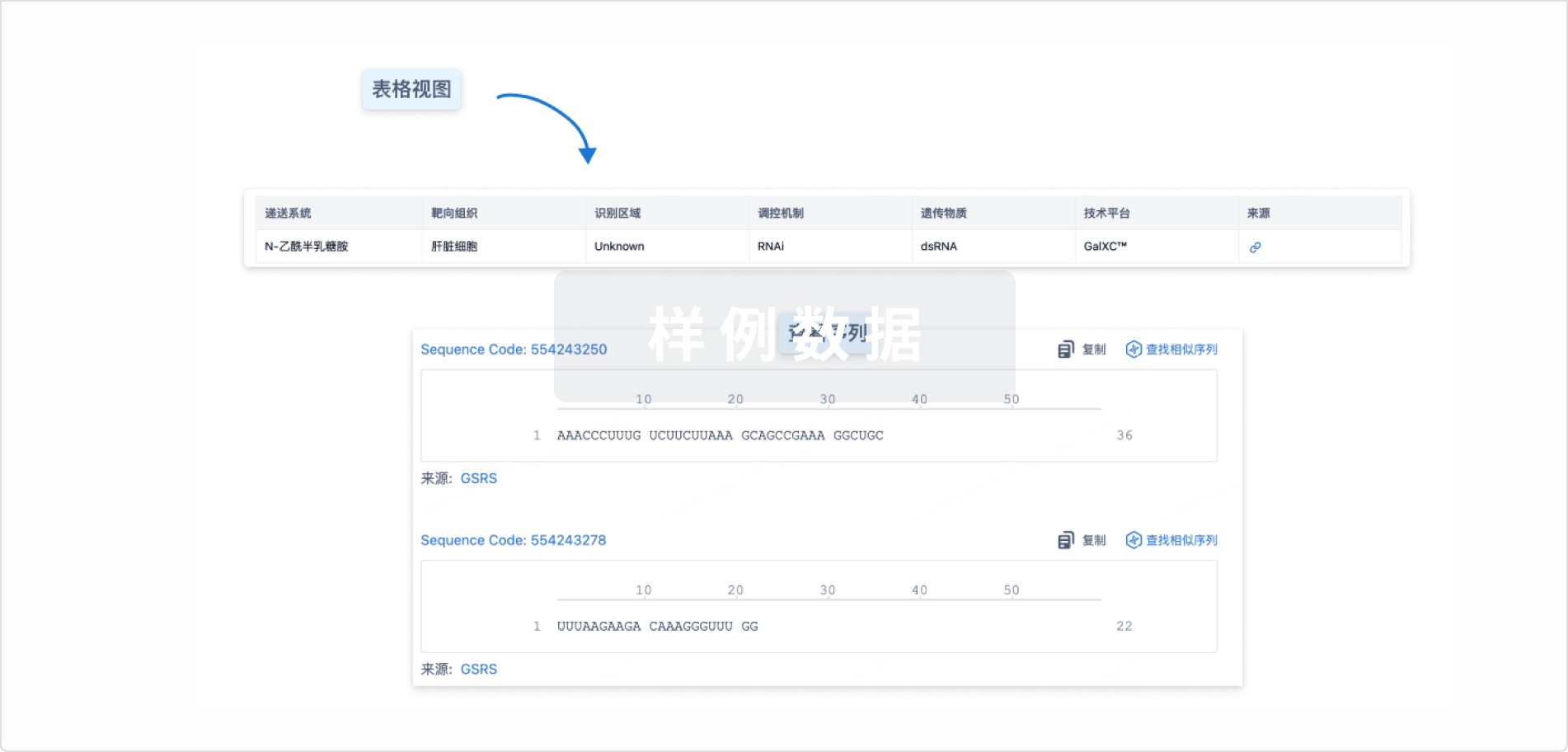预约演示
更新于:2025-12-27
REP-2165
更新于:2025-12-27
概要
基本信息
原研机构 |
在研机构- |
非在研机构 |
权益机构- |
最高研发阶段无进展临床2期 |
首次获批日期- |
最高研发阶段(中国)- |
特殊审评- |
登录后查看时间轴
结构/序列
使用我们的RNA技术数据为新药研发加速。
登录
或

Sequence Code 29538155

关联
1
项与 REP-2165 相关的临床试验NCT02565719
An Open-label, Randomized, Active Controlled, Parallel Comparison Study of the Safety and Efficacy of REP 2139-Mg in Combination With Pegasys® and Viread® and REP 2165-Mg in Combination With Pegasys® and Viread® in Patients With HBeAg Negative Chronic Hepatitis B
NAPs have been previously shown to clear serum hepatitis B virus surface antigen (HBsAg) both preclinically (in duck HBV infected ducks) and in human patients. REP 2139-Ca mediated HBsAg clearance acts synergistically with immunotherapeutic agent pegylated interferon-alpha 2a to restore host immunological control of HBV infection. REP 2165 is a version of REP 2139 which has been shown preclinically to retain antiviral activity with lower accumulation in the liver.
Both REP 2139 and REP 2165 used in this protocol are formulated as magnesium chelate complexes, which improve their administration tolerability. This open label, randomized and controlled study will examine the safety and efficacy of REP 2139-Mg and REP 2165-Mg therapy in patients with HBeAg negative chronic hepatitis B when used in combination with tenofovir disoproxil fumarate and pegylated interferon alpha-2a.
Both REP 2139 and REP 2165 used in this protocol are formulated as magnesium chelate complexes, which improve their administration tolerability. This open label, randomized and controlled study will examine the safety and efficacy of REP 2139-Mg and REP 2165-Mg therapy in patients with HBeAg negative chronic hepatitis B when used in combination with tenofovir disoproxil fumarate and pegylated interferon alpha-2a.
开始日期2016-03-01 |
申办/合作机构 |
100 项与 REP-2165 相关的临床结果
登录后查看更多信息
100 项与 REP-2165 相关的转化医学
登录后查看更多信息
100 项与 REP-2165 相关的专利(医药)
登录后查看更多信息
5
项与 REP-2165 相关的文献(医药)2024-04-01·Antiviral research
An in vivo duck hepatitis B virus model recapitulates key aspects of nucleic acid polymer treatment outcomes in chronic hepatitis B patients
Article
作者: Chanda, Sushmita ; Hong, Jin ; Ebwanga, Ebanja Joseph ; Raboisson, Pierre ; Beigelman, Leonid ; Thatikonda, Santhosh Kumar ; Kum, Dieudonné Buh ; Acosta Sanchez, Abel ; Debing, Yannick ; Rajwanshi, Vivek ; Kariuki, Christopher Kinyanjui ; Merckx, Wouter ; Silva de Oliveira, Daniel Apolônio ; Symons, Julian A ; Gohil, Vikrant ; Vanrusselt, Hannah ; Lin, Tse-I ; Smith, David B ; Blatt, Lawrence M ; Bashir, Shahbaz ; Jekle, Andreas ; Paeshuyse, Jan ; Degrauwe, Lars
Nucleic acid polymers (NAPs) are an attractive treatment modality for chronic hepatitis B (CHB), with REP2139 and REP2165 having shown efficacy in CHB patients. A subset of patients achieve functional cure, whereas the others exhibit a moderate response or are non-responders. NAP efficacy has been difficult to recapitulate in animal models, with the duck hepatitis B virus (DHBV) model showing some promise but remaining underexplored for NAP efficacy testing. Here we report on an optimized in vivo DHBV duck model and explore several characteristics of NAP treatment. REP2139 was efficacious in reducing DHBV DNA and DHBsAg levels in approximately half of the treated ducks, whether administered intraperitoneally or subcutaneously. Intrahepatic or serum NAP concentrations did not correlate with efficacy, nor did the appearance of anti-DHBsAg antibodies. Furthermore, NAP efficacy was only observed in experimentally infected ducks, not in endogenously infected ducks (vertical transmission). REP2139 add-on to entecavir treatment induced a deeper and more sustained virological response compared to entecavir monotherapy. Destabilized REP2165 showed a different activity profile with a more homogenous antiviral response followed by a faster rebound. In conclusion, subcutaneous administration of NAPs in the DHBV duck model provides a useful tool for in vivo evaluation of NAPs. It recapitulates many aspects of this class of compound's efficacy in CHB patients, most notably the clear division between responders and non-responders.
2021-03-01·Gastroenterology
Clarifying the Chemistry, Activity, and Safety of Nucleic Acid Polymers
Letter
作者: Vaillant, Andrew
In the editorial entitled ''Nucleic Acid Polymers are Effective in Targeting Hepatitis B Surface Antigen, But More Trials Are Needed'' commenting on the recent publication of the REP 401 study in Gastroenterol., ''Safety and Efficacy of 48 Wk REP 2139 or REP 2165, Tenofovir Disoproxil, and Pegylated Interferon Alfa-2a in Patients With Chronic HBV Infection Naive to Nucleos(t)ide Therapy,'' it is important to clarify several statements that are at opposition to or inconsistent with the large body of published data on nucleic acid polymers (NAPs) to date.The target(s) of NAPs driving their activity are of great interest but a NAP-hepatitis B surface antigen (HBsAg) interaction as suggested in the editorial has been excluded.
2020-06-01·Gastroenterology1区 · 医学
Safety and Efficacy of 48 Weeks REP 2139 or REP 2165, Tenofovir Disoproxil, and Pegylated Interferon Alfa-2a in Patients With Chronic HBV Infection Naïve to Nucleos(t)ide Therapy
1区 · 医学
Article
作者: Musteata, Tatiana ; Placinta, Gheorghe ; Jimbei, Pavlina ; Krawczyk, Adalbert ; Jucov, Alina ; Moscalu, Iurie ; Cojuhari, Lilia ; Pântea, Victor ; Cebotarescu, Valentin ; Smesnoi, Valentina ; Bazinet, Michel ; Dittmer, Ulf ; Iarovoi, Liviu ; Vaillant, Andrew
BACKGROUND & AIMS:
Nucleic acid polymers (NAPs) inhibit assembly and secretion of hepatitis B virus (HBV) subviral particles. We performed an open-label, phase 2 study of the safety and efficacy of the NAPs REP 2139 or REP 2165 combined with tenofovir disoproxil fumarate (TDF) and pegylated interferon alfa-2a (pegIFN) in patients with chronic HBV infection who were negative for hepatitis B e antigen.
METHODS:
Following 24 weeks TDF therapy, 40 patients were randomly assigned to groups that received 48 weeks of experimental therapy (TDF + pegIFN + REP 2139-Mg or REP 2165-Mg) or 24 weeks of control therapy (TDF + pegIFN) followed by 48 weeks of experimental therapy. Patients were then followed for a treatment-free period of 48 weeks. Primary outcomes were the safety and tolerability of REP 2139-Mg or REP 2165-Mg in combination with TDF + pegIFN compared with TDF + pegIFN alone through the first 48 weeks of therapy and subsequently throughout 48 weeks of NAP-based combination therapy (treatment weeks 24-72 in the experimental group and weeks 48-96 in the control group). Secondary outcomes were reductions in hepatitis B surface antigen (HBsAg) in control and experimental groups over the first 48 weeks of the study and throughout 48 weeks of combination therapy and virologic control (HBsAg positive, HBV DNA below 2000 IU/mL, normal level of alanine aminotransferase) or functional cure (HBsAg below 0.05 IU/mL, HBV DNA target not detected, normal level of alanine aminotransferase) after removal of all therapy.
RESULTS:
Levels of HBsAg, anti-HBs, and HBV DNA did not differ significantly between the groups given REP 2139 vs REP 2165. PegIFN-induced thrombocytopenia (P = .299 vs controls) and neutropenia (P = .112 vs controls) were unaffected by NAPs (REP 2139 vs REP 2165). Increases in levels of transaminases were significantly more frequent (P < .001 vs controls) and greater (P = .002 vs controls) in the NAP groups (but did not produce symptoms), correlated with initial decrease in HBsAg, and normalized during therapy and follow-up. During the first 24 weeks of TDF and pegIFN administration, significantly higher proportions of patients in NAP groups had decreases in HBsAg to below 1 IU/mL (P < .001 vs control) and HBsAg seroconversion (P = .046 vs control). At the time patients completed the TDF + pegIFN + NAP regimen, HBsAg levels were 0.05 IU/mL or lower in 24/40 participants (all with seroconversion up to 233,055 mIU/mL). During 48 weeks of treatment-free follow-up, virologic control persisted in 13 of 40 participants (2 lost to follow-up after 24 weeks), whereas functional cure persisted in 14 of 40 participants (all completing 48 weeks of follow-up) with persistent HBsAg seroconversion. One participant had a viral rebound during follow-up with hepatic decompensation and was placed on TDF therapy.
CONCLUSIONS:
In a phase 2 randomized trial, we found that addition of NAPs to TDF + pegIFN did not alter tolerability and significantly increased rates of HBsAg loss and HBsAg seroconversion during therapy and functional cure after therapy. Clinicaltrials.gov no: NCT02565719.
8
项与 REP-2165 相关的新闻(医药)2025-11-18
·一点资讯
乙肝功能性治愈有望从梦想照进现实。11月7日—11日在华盛顿举办的2025年美国肝病学会年会(AASLD 2025)上,南方医科大学南方医院侯金林教授团队展示最新数据,星曜坤泽生物的两款抗乙肝病毒药物HT-101+HT-102联合疗法在II期研究中表现出良好效果,20周内乙肝表面抗原清除率最高达到90%,刷新乙肝功能性治愈新纪录。除此之外,近期不断有令人振奋的消息传来。9月15日,来恩生物的LioCyx-M004获FDA批准开展Ib/2期临床试验,成为全球首个获得FDA批准用于慢性乙型肝炎(CHB)治疗的TCR-T细胞疗法,也是首个获得FDA快速通道资格的乙肝病毒特异性TCR-T疗法。9月22日,悦康药业的乙型肝炎siRNA新药YKYY013注射液,获得FDA批准开展用于治疗CHB病毒感染的临床试验。就在同一个月,恒瑞医药HRS-5635和苏州星曜坤泽HT-101两款siRNA乙肝创新药,双双被CDE纳入突破性疗法。各种技术路线竞相突破,乙肝治疗领域正掀起一场前所未有的创新浪潮。百亿市场亟待开发乙肝治疗是一个“看似饱和、实则亟待创新性突破”的市场,蕴含着巨大的商业价值。首先,乙型肝炎是由乙型肝炎病毒(HBV)引起的以肝脏炎症为特征的传染性疾病,感染后可能发展为慢性肝炎、肝硬化、肝衰竭和肝细胞癌。作为一种会引起多器官损害的传染性疾病,乙肝难治愈且易复发,需长期甚至终身用药。其次,乙肝患者基数庞大。根据《2024年全球肝炎报告》,2022年全球约有2.54亿人为慢性HBV感染者。而我国是乙肝大国,全球乙肝患者三分之一在中国。据《慢性乙型肝炎防治指南(2022年版)》显示,我国慢性乙型肝炎病毒感染者约为8600万,慢性乙型肝炎患者约为2000万至3000万例。再者,现有疗法存在局限性,仍存在较大未被满足的临床需求。目前,乙肝主要治疗手段为核苷(酸)类似物(NAs)和干扰素。其中,NAs药物具有抗病毒能力强、口服方便等优点,但疗程长,大多数患者需要长期用药以减少复发,而且单药治疗HBsAg(乙型肝炎表面抗原)清除率仅为0—3%;干扰素的优点在于疗程短而固定、不易耐药,单药治疗一年HBsAg清除率较高(3%—11%),但抗病毒能力弱,且需要注射。乙肝治疗药物/图源:西部证券研报由于单药疗效有限,临床上主流的治疗方案逐渐转向联合用药。据临床研究表明,NAs联合干扰素能够将HBsAg清除率提升到接近30%,部分优势患者的清除率能够达到80%。即便如此,临床上仍然期盼着一些能弥补上述局限性的全新疗法。就像攻克丙肝一样,医学界一直希望能够实现乙肝的“完全治愈”,即血清HBsAg检测不到,cccDNA(共价闭合环状DNA)和整合HBV DNA被清除。然而,由于cccDNA转录受到宿主细胞表观遗传机制的调节而稳定存在,目前缺少特异性靶向cccDNA的药物,完全治愈较难实现。因此,临床治愈(功能性治愈)成为现阶段国内外CHB防治指南公认的理想治疗目标,也就是停止治疗后HBsAg持续阴性,伴或不伴抗-HBs出现,HBV DNA低于最低检测下限,肝脏生物化学指标正常,肝细胞内仍存在cccDNA和整合的HBV DNA。简言之,就是以临床症状消失、肝功能正常为目标。庞大的患者人群叠加现有疗法的局限性,对应着广阔的市场前景。根据弗若斯特沙利文预测,随着乙肝诊疗率逐步提升,以及更多乙肝治疗创新药物上市,中国乙肝药物市场规模预计将呈现大幅增长,预计到2030年将达到723亿元。多技术路线探索现有疗法虽然能控制病情,但远未令人满意。巨大的临床与市场缺口,为所有敢于挑战乙肝功能性治愈的药企提供了历史性机遇。目前,针对乙肝适应症的直接抗病毒药物研发正在如火如荼地进行中,包括衣壳抑制剂、反义寡核苷酸(ASO)、小干扰RNA(siRNA)、HBsAg抑制剂等。(1)衣壳抑制剂衣壳自组装为病毒生命周期的关键步骤且具有极强的保守性,衣壳抑制剂可干扰HBV衣壳组装,从而强烈抑制HBV复制及成熟病毒颗粒的产生。目前全球尚无针对乙肝的衣壳抑制剂获批上市,已进入临床阶段的管线包括东阳光药甲磺酸莫非赛定(GLS4)、广生堂GST-HG141(奈瑞可韦)、挚盟医药ZM-H1505R(Canocapavir,科诺卡帕韦)、Aligos Therapeutics的衣壳组装调节剂(CAM)前药ALG-000184等,其中前三者均已进入临床III期阶段。ALG-000184是具有皮摩尔效力的泛基因型II型衣壳组装调节剂(CAM-E),正在开展II期研究。根据2025亚太肝病学会(APASL)年会公布的临床数据显示,300mg ALG-000184单药治疗96周可在慢性HBV感染受试者中实现持续、显著的HBV DNA抑制,且无病毒突破。(2)ASO药物ASO是小核酸药物研发的热点。小核酸药物具有高度的靶向性,可以通过碱基互补配对原则,与乙肝病毒的mRNA或其他关键RNA序列结合,而且还能影响cccDNA的转录过程,让cccDNA处于“沉默”状态,从而实现乙肝的功能性治愈。目前,已进入临床阶段的乙肝ASO药物,包括Ionis Pharmaceuticals开发并授权葛兰素史克的Bepirovirsen(GSK836/IONIS-HBVRx)和IONIS-HBV-LRx、浩博医药的非偶联型ASO药物AHB-137等。Bepirovirsen全球进度最快,有望成为全球首个“功能性治愈”慢性乙型肝炎的药物,预计2026年公布III期数据,并向美国、欧盟、中国、日本提交上市申请。根据IIa期临床研究,Bepirovirsen 300mg治疗29天可降低HBsAg水平,且安全性和耐受性良好。根据B-Together研究,Bepirovirsen治疗24周后,35%的患者达到HBsAg清除。(3)siRNA疗法siRNA疗法可以抑制HBV抗原表达,阻断病毒复制,减轻免疫耐受,还能抑制来自整合HBV-DNA和cccDNA的HBsAg。目前全球尚无乙肝siRNA药物获批上市,已进入临床阶段的管线包括Vir Biotechnology的VIR-2218(elebsiran,BRII-835),GSK的GSK5637608(JNJ-3989)、Arbutus Biopharma的AB-729、瑞博生物RBD1016(SR016)、恒瑞医药HRS-5635等。全球慢性乙肝(HBV靶点)siRNA药物研发进展/图源:国泰海通证券研报近期,星曜坤泽公布其HT-101(乙肝siRNA)+HT-102(乙肝中和抗体)联合疗法,为全球慢性乙肝患者带来了治愈新希望。Ib/IIa期研究结果显示,在联合治疗组中,高剂量组中有90%的患者在第20周时实现了HBsAg清除,刷新乙肝功能性治愈新纪录;基线HBsAg水平较低的患者,20周后全部实现表面抗原转阴;HT-101和HT-102单药及联合治疗总体安全且耐受良好。各组HBsAg下降趋势(第0–20周)/图源:南方医科大学国际交流与合作处官微(4)HBsAg抑制剂HBsAg抑制剂是一种针对乙型肝炎表面抗原(HBsAg)的药物,主要是核酸聚合物NAPs,通过阻断HBsAg和亚病毒颗粒的释放以控制HBV的复制和感染过程。目前,已进入临床阶段的HBsAg抑制剂,包括Replicor的REP2139/REP2165、广生堂的GST-HG131和GST-HG121等。中国药企抢滩从目前发展与布局情况看,各种技术路线都能看到中国药企的身影。例如,广生堂在2015年提出乙肝临床治愈路线图“登峰计划”,通过GST-HG141、GST-HG131、GST-HG121及现有NAs抗乙肝病毒药物多靶点联合用药,实现乙肝临床治愈。GST-HG141(奈瑞可韦)是一种新型口服乙肝病毒核心蛋白调节剂,针对乙肝病毒复制的多个关键环节产生作用,既能有效抑制乙肝病毒的核衣壳组装,又通过源头上阻断HBV在肝细胞核脱壳,从而耗竭cccDNA储备池,是乙肝临床治愈的关键环节。目前,该药已进入III期阶段。Ib期和II期临床结果显示,GST-HG141安全性良好,具有优异的HBVDNA和pgRNA抑制效果,同时间接体现了对cccDNA的耗竭作用,展现出不同于核苷类似物的作用机制及与核苷类似物的协同效应。GST-HG131是全球首个完成II期临床研究的口服HBsAg抑制剂,能够诱导HBV-RNA降解,降低HBsAg水平,且具有良好的安全性。在临床II期研究中,GST-HG131在病人服用12周后从基线降低血清表面抗原值平均为0.9log IU/ml,最高达1.64log IU/ml;更重要的是,GST-HG131仅使用三个月就可将76.5%的乙肝病人血清表面抗原水平降低到100IU/ml以下。GST-HG131能在乙肝病人上显著降低HBsAg,而且正在开展联合GST-HG141挑战乙肝临床治愈的II期研究。另一款HBsAg抑制剂GST-HG121正在开展I期研究,基础研究表明可有效地抑制HBsAg表达,降低乙肝表面抗原滴度,有望提高乙肝表面抗原转阴率。广生堂的乙肝疗法管线/图源:2025年半年度报告中国生物制药布局了多款慢性乙肝治疗药物,包括TQA3038(siRNA疗法)、TQA3334(TLR-7激动剂)、TQA3810(TLR-8激动剂),均已处于II期临床。东阳光药布局了核心蛋白变构调节剂(CpAM)甲磺酸莫非赛定胶囊(GLS4),还基于GLS4改良出一款已处于II期阶段的CAM药物福瑞赛定(Freethiadine),而且siRNA药物HECN30227已申报临床,可同时消除cccDNA和intDNA来源的HBsAg。恒瑞医药的新一代肝靶向HBV的siRNA药物HRS-5635,是新型共价偶联三触角型N-乙酰半乳糖胺(GalNAc)的双链小干扰RNA。根据单药治疗慢乙肝的II期研究结果显示,HRS-5635有提高慢乙肝功能性治愈的潜力,且同时具备良好的安全性特征。此外,HRS-5635联合聚乙二醇干扰素α(Peg-IFNα)治疗慢乙肝的II期研究正在进行中。腾盛博药从VBI Vaccines, Inc.引进的治疗性疫苗BRII-179(VBI-2601)已处于临床II期。根据2025年AASLD上发布的ENSURE II期研究队列4治疗结束(EOT)后24周的随访结果,BRII-179抗-HBs应答者HBsAg下降速度更快、幅度更大,支持BRII-179在实现更快速、更持久HBsAg清除及潜在缩短PEG-IFNα治疗周期方面的潜力。此外,腾盛博药从Vir Biotechnology引进的GalNAc偶联siRNA药物VIR-2218,联合聚乙二醇干扰素α治疗HBV显示出优异的HBsAg清除率,目前处于II期临床。值得一提的是,星汉德生物的HBV特异性TCR-T细胞疗法SCG101,在治疗晚期HBV相关肝细胞癌患者中展现出令人瞩目的抗病毒和抗肿瘤双重效果,根据2025欧洲肝脏研究协会(EASL)大会公布的临床数据,患者在接受单次SCG101输注治疗后,全部获得血清HBsAg快速断崖式下降,其中高达94%的患者HBsAg在28天内降幅达到1.0-4.6log,并在长达一年的随访期间患者HBsAg持续维持在低于100IU/mL的水平。当中有23.5%的患者在接受治疗后的21天内实现HBsAg完全清除,并且在整个随访期内一直保持在清除状态。结语乙肝药市场正迎来多技术路线竞逐的黄金时代,全球药企围绕“功能性治愈”这一目标展开了激烈竞逐。
2025-11-17
·药创新
多技术路线探索
撰文丨粽哥2025
乙肝功能性治愈有望从梦想照进现实。
11月7日—11日在华盛顿举办的2025年美国肝病学会年会(AASLD 2025)上,南方医科大学南方医院侯金林教授团队展示最新数据,星曜坤泽生物的两款抗乙肝病毒药物HT-101+HT-102联合疗法在II期研究中表现出良好效果,20周内乙肝表面抗原清除率最高达到90%,刷新乙肝功能性治愈新纪录。
除此之外,近期不断有令人振奋的消息传来。
9月15日,来恩生物的LioCyx-M004获FDA批准开展Ib/2期临床试验,成为全球首个获得FDA批准用于慢性乙型肝炎(CHB)治疗的TCR-T细胞疗法,也是首个获得FDA快速通道资格的乙肝病毒特异性TCR-T疗法。
9月22日,悦康药业的乙型肝炎siRNA新药YKYY013注射液,获得FDA批准开展用于治疗CHB病毒感染的临床试验。就在同一个月,恒瑞医药HRS-5635和苏州星曜坤泽HT-101两款siRNA乙肝创新药,双双被CDE纳入突破性疗法。
各种技术路线竞相突破,乙肝治疗领域正掀起一场前所未有的创新浪潮。
百亿市场亟待开发
乙肝治疗是一个“看似饱和、实则亟待创新性突破”的市场,蕴含着巨大的商业价值。
首先,乙型肝炎是由乙型肝炎病毒(HBV)引起的以肝脏炎症为特征的传染性疾病,感染后可能发展为慢性肝炎、肝硬化、肝衰竭和肝细胞癌。作为一种会引起多器官损害的传染性疾病,乙肝难治愈且易复发,需长期甚至终身用药。
其次,乙肝患者基数庞大。根据《2024年全球肝炎报告》,2022年全球约有2.54亿人为慢性HBV感染者。而我国是乙肝大国,全球乙肝患者三分之一在中国。据《慢性乙型肝炎防治指南(2022年版)》显示,我国慢性乙型肝炎病毒感染者约为8600万,慢性乙型肝炎患者约为2000万至3000万例。
再者,现有疗法存在局限性,仍存在较大未被满足的临床需求。
目前,乙肝主要治疗手段为核苷(酸)类似物(NAs)和干扰素。其中,NAs药物具有抗病毒能力强、口服方便等优点,但疗程长,大多数患者需要长期用药以减少复发,而且单药治疗HBsAg(乙型肝炎表面抗原)清除率仅为0—3%;干扰素的优点在于疗程短而固定、不易耐药,单药治疗一年HBsAg清除率较高(3%—11%),但抗病毒能力弱,且需要注射。
乙肝治疗药物/图源:西部证券研报
由于单药疗效有限,临床上主流的治疗方案逐渐转向联合用药。据临床研究表明,NAs联合干扰素能够将HBsAg清除率提升到接近30%,部分优势患者的清除率能够达到80%。
即便如此,临床上仍然期盼着一些能弥补上述局限性的全新疗法。
就像攻克丙肝一样,医学界一直希望能够实现乙肝的“完全治愈”,即血清HBsAg检测不到,cccDNA(共价闭合环状DNA)和整合HBV DNA被清除。然而,由于cccDNA转录受到宿主细胞表观遗传机制的调节而稳定存在,目前缺少特异性靶向cccDNA的药物,完全治愈较难实现。
因此,临床治愈(功能性治愈)成为现阶段国内外CHB防治指南公认的理想治疗目标,也就是停止治疗后HBsAg持续阴性,伴或不伴抗-HBs出现,HBV DNA低于最低检测下限,肝脏生物化学指标正常,肝细胞内仍存在cccDNA和整合的HBV DNA。简言之,就是以临床症状消失、肝功能正常为目标。
庞大的患者人群叠加现有疗法的局限性,对应着广阔的市场前景。根据弗若斯特沙利文预测,随着乙肝诊疗率逐步提升,以及更多乙肝治疗创新药物上市,中国乙肝药物市场规模预计将呈现大幅增长,预计到2030年将达到723亿元。
多技术路线探索
现有疗法虽然能控制病情,但远未令人满意。巨大的临床与市场缺口,为所有敢于挑战乙肝功能性治愈的药企提供了历史性机遇。
目前,针对乙肝适应症的直接抗病毒药物研发正在如火如荼地进行中,包括衣壳抑制剂、反义寡核苷酸(ASO)、小干扰RNA(siRNA)、HBsAg抑制剂等。
(1)衣壳抑制剂
衣壳自组装为病毒生命周期的关键步骤且具有极强的保守性,衣壳抑制剂可干扰HBV衣壳组装,从而强烈抑制HBV复制及成熟病毒颗粒的产生。
目前全球尚无针对乙肝的衣壳抑制剂获批上市,已进入临床阶段的管线包括东阳光药甲磺酸莫非赛定(GLS4)、广生堂GST-HG141(奈瑞可韦)、挚盟医药ZM-H1505R(Canocapavir,科诺卡帕韦)、Aligos Therapeutics的衣壳组装调节剂(CAM)前药ALG-000184等,其中前三者均已进入临床III期阶段。
ALG-000184是具有皮摩尔效力的泛基因型II型衣壳组装调节剂(CAM-E),正在开展II期研究。根据2025亚太肝病学会(APASL)年会公布的临床数据显示,300mg ALG-000184单药治疗96周可在慢性HBV感染受试者中实现持续、显著的HBV DNA抑制,且无病毒突破。
(2)ASO药物
ASO是小核酸药物研发的热点。小核酸药物具有高度的靶向性,可以通过碱基互补配对原则,与乙肝病毒的mRNA或其他关键RNA序列结合,而且还能影响cccDNA的转录过程,让cccDNA处于“沉默”状态,从而实现乙肝的功能性治愈。
目前,已进入临床阶段的乙肝ASO药物,包括Ionis Pharmaceuticals开发并授权葛兰素史克的Bepirovirsen(GSK836/IONIS-HBVRx)和IONIS-HBV-LRx、浩博医药的非偶联型ASO药物AHB-137等。
Bepirovirsen全球进度最快,有望成为全球首个“功能性治愈”慢性乙型肝炎的药物,预计2026年公布III期数据,并向美国、欧盟、中国、日本提交上市申请。根据IIa期临床研究,Bepirovirsen 300mg治疗29天可降低HBsAg水平,且安全性和耐受性良好。根据B-Together研究,Bepirovirsen治疗24周后,35%的患者达到HBsAg清除。
(3)siRNA疗法
siRNA疗法可以抑制HBV抗原表达,阻断病毒复制,减轻免疫耐受,还能抑制来自整合HBV-DNA和cccDNA的HBsAg。
目前全球尚无乙肝siRNA药物获批上市,已进入临床阶段的管线包括Vir Biotechnology的VIR-2218(elebsiran,BRII-835),GSK的GSK5637608(JNJ-3989)、Arbutus Biopharma的AB-729、瑞博生物RBD1016(SR016)、恒瑞医药HRS-5635等。
全球慢性乙肝(HBV靶点)siRNA药物研发进展/图源:国泰海通证券研报
近期,星曜坤泽公布其HT-101(乙肝siRNA)+HT-102(乙肝中和抗体)联合疗法,为全球慢性乙肝患者带来了治愈新希望。Ib/IIa期研究结果显示,在联合治疗组中,高剂量组中有90%的患者在第20周时实现了HBsAg清除,刷新乙肝功能性治愈新纪录;基线HBsAg水平较低的患者,20周后全部实现表面抗原转阴;HT-101和HT-102单药及联合治疗总体安全且耐受良好。
各组HBsAg下降趋势(第0–20周)/图源:南方医科大学国际交流与合作处官微
(4)HBsAg抑制剂
HBsAg抑制剂是一种针对乙型肝炎表面抗原(HBsAg)的药物,主要是核酸聚合物NAPs,通过阻断HBsAg和亚病毒颗粒的释放以控制HBV的复制和感染过程。
目前,已进入临床阶段的HBsAg抑制剂,包括Replicor的REP2139/REP2165、广生堂的GST-HG131和GST-HG121等。
中国药企抢滩
从目前发展与布局情况看,各种技术路线都能看到中国药企的身影。
例如,广生堂在2015年提出乙肝临床治愈路线图“登峰计划”,通过GST-HG141、GST-HG131、GST-HG121及现有NAs抗乙肝病毒药物多靶点联合用药,实现乙肝临床治愈。
GST-HG141(奈瑞可韦)是一种新型口服乙肝病毒核心蛋白调节剂,针对乙肝病毒复制的多个关键环节产生作用,既能有效抑制乙肝病毒的核衣壳组装,又通过源头上阻断HBV在肝细胞核脱壳,从而耗竭cccDNA储备池,是乙肝临床治愈的关键环节。目前,该药已进入III期阶段。
Ib期和II期临床结果显示,GST-HG141安全性良好,具有优异的HBVDNA和pgRNA抑制效果,同时间接体现了对cccDNA的耗竭作用,展现出不同于核苷类似物的作用机制及与核苷类似物的协同效应。
GST-HG131是全球首个完成II期临床研究的口服HBsAg抑制剂,能够诱导HBV-RNA降解,降低HBsAg水平,且具有良好的安全性。在临床II期研究中,GST-HG131在病人服用12周后从基线降低血清表面抗原值平均为0.9log IU/ml,最高达1.64log IU/ml;更重要的是,GST-HG131仅使用三个月就可将76.5%的乙肝病人血清表面抗原水平降低到100IU/ml以下。
GST-HG131能在乙肝病人上显著降低HBsAg,而且正在开展联合GST-HG141挑战乙肝临床治愈的II期研究。
另一款HBsAg抑制剂GST-HG121正在开展I期研究,基础研究表明可有效地抑制HBsAg表达,降低乙肝表面抗原滴度,有望提高乙肝表面抗原转阴率。
广生堂的乙肝疗法管线/图源:2025年半年度报告
中国生物制药布局了多款慢性乙肝治疗药物,包括TQA3038(siRNA疗法)、TQA3334(TLR-7激动剂)、TQA3810(TLR-8激动剂),均已处于II期临床。
东阳光药布局了核心蛋白变构调节剂(CpAM)甲磺酸莫非赛定胶囊(GLS4),还基于GLS4改良出一款已处于II期阶段的CAM药物福瑞赛定(Freethiadine),而且siRNA药物HECN30227已申报临床,可同时消除cccDNA和intDNA来源的HBsAg。
恒瑞医药的新一代肝靶向HBV的siRNA药物HRS-5635,是新型共价偶联三触角型N-乙酰半乳糖胺(GalNAc)的双链小干扰RNA。
根据单药治疗慢乙肝的II期研究结果显示,HRS-5635有提高慢乙肝功能性治愈的潜力,且同时具备良好的安全性特征。此外,HRS-5635联合聚乙二醇干扰素α(Peg-IFNα)治疗慢乙肝的II期研究正在进行中。
腾盛博药从VBI Vaccines, Inc.引进的治疗性疫苗BRII-179(VBI-2601)已处于临床II期。根据2025年AASLD上发布的ENSURE II期研究队列4治疗结束(EOT)后24周的随访结果,BRII-179抗-HBs应答者HBsAg下降速度更快、幅度更大,支持BRII-179在实现更快速、更持久HBsAg清除及潜在缩短PEG-IFNα治疗周期方面的潜力。
此外,腾盛博药从Vir Biotechnology引进的GalNAc偶联siRNA药物VIR-2218,联合聚乙二醇干扰素α治疗HBV显示出优异的HBsAg清除率,目前处于II期临床。
值得一提的是,星汉德生物的HBV特异性TCR-T细胞疗法SCG101,在治疗晚期HBV相关肝细胞癌患者中展现出令人瞩目的抗病毒和抗肿瘤双重效果,
根据2025欧洲肝脏研究协会(EASL)大会公布的临床数据,患者在接受单次SCG101输注治疗后,全部获得血清HBsAg快速断崖式下降,其中高达94%的患者HBsAg在28天内降幅达到1.0-4.6log,并在长达一年的随访期间患者HBsAg持续维持在低于100IU/mL的水平。当中有23.5%的患者在接受治疗后的21天内实现HBsAg完全清除,并且在整个随访期内一直保持在清除状态。
结语
乙肝药市场正迎来多技术路线竞逐的黄金时代,全球药企围绕“功能性治愈”这一目标展开了激烈竞逐。
可以预见的是,未来这一领域将迎来更多创新药物,为改写乙肝治疗格局带来希望。
END
往期精彩内容
麦肯锡剖析创新药“中国模式”,未来5年如何变化?
辉瑞中国刘菁:深耕创新研发,以匠心服务皮肤疾病患者
辉瑞中国张建辉:以创新之力,铺就县域医疗高质量发展之路
细胞疗法突破性疗法siRNAASH会议临床申请
2025-11-12
·今日头条
随着乙肝治疗技术的稳步发展,慢乙肝临床治愈已经从曾经的理想目标,变成了可实现的治疗目标!
什么是慢乙肝临床治愈?
所谓临床治愈是指:慢乙肝患者经过规范治疗停药后,仍能长期维持以下状态:
①表面抗原(HBsAg)转阴
,无论是否出现表面抗体,均符合标准;
②乙肝病毒 DNA(HBV DNA)
持续处于检测下限以下;
③肝功能各项指标保持正常
,无异常波动;
④通过 B 超等影像学检查,确认肝脏组织无其他病变
。
更关键的是,这些指标需要在
停药后 24 周依然稳定不变
,才算达到临床治愈标准。
这一目标是目前国内外诊疗指南一致推荐的理想方向,也是慢乙肝抗病毒治疗的最高追求。实现临床治愈后,患者后续发生乙肝相关性肝硬化、肝癌的风险会大幅下降,基本与健康人持平,还能长期安全停药,摘掉 “乙肝患者” 的帽子[1]。
长效干扰素:临床治愈的核心助力
长效干扰素在慢乙肝临床治愈中发挥着不可替代的作用。研究表明,它具备 “抗病毒 + 免疫调节” 的双重机制:一方面,能促进体内免疫因子表达,增强免疫系统功能,让免疫细胞精准识别并清除被乙肝病毒感染的肝细胞;另一方面,它可直接与受感染的肝细胞结合,抑制病毒复制,发挥直接抗病毒效果[2-3]。
正因为这种双重优势,目前多数慢乙肝临床治愈方案都围绕长效干扰素构建,比如长效干扰素单药治疗、与核苷类药物联合治疗,或是联合胸腺肽等其他免疫调节剂。
而 “中国慢乙肝临床治愈(珠峰)工程项目”“星光计划”“萌芽项目”“容愈项目” 等多项临床实践,也充分证实了这些方案的有效性,已有越来越多患者通过这类治疗成功实现临床治愈。
2025 年 10 月,国家药品监督管理局正式批准聚乙二醇干扰素 α-2b 联合核苷类药物,用于成人慢乙肝患者的乙肝表面抗原持续性清除,进一步肯定了其临床价值。
新药研发:为临床治愈添砖加瓦
除了长效干扰素,各类慢乙肝新药也在加速推进,成为助力临床治愈的重要力量,不少药物已进入深度研发阶段,有望尽快应用于临床。
其中,GSK32288836(简称 GSK836)是目前少数进入 Ⅲ 期临床试验的新药,关注度较高。其 Ⅱb 期研究结果显示,单药治疗 24 周后,26% 的核苷类药物经治患者和 29% 未联合核苷类药物的患者,能实现表面抗原清除与 HBV DNA 阴转,但该药物的持久效果欠佳 —— 随访 24 周后,超过 60% 的患者出现表面抗原反弹,复发率相对较高。
这一现象可能与药物无法激活机体免疫功能、难以维持长期免疫应答有关。后续研究发现,将其与干扰素 α 联合治疗,能显著降低复发风险,且联合治疗启动时间越早,效果越理想[4]。
国内新药 AHB-137 同样处于 Ⅲ 期临床试验阶段。前期研究数据显示,该药治疗 24 周后,超 60% 的患者可实现表面抗原清除与 HBV DNA 阴转,但最新结果表明,停用 AHB-137 后改用核苷类药物维持治疗 24 周,有 61% 的患者出现复阳,复发率与 GSK836 相近,持久疗效仍需通过进一步研究优化[4]。
此外,REP2139/REP2165、RG6346、JNJ-3989 等多款新药也在推进临床研究[5],基因编辑疗法 PBGENE-HBV 也已获得临床试验批准,即将开展相关探索[6]。
乙肝治疗的未来可期
随着医学技术的持续突破,慢乙肝早已不是 “必须终生服药” 的疾病。通过规范的抗病毒治疗,众多患者能够实现临床治愈,安全停药。
目前,基于干扰素的治疗方案是目前实现临床治愈的主要方案,而针对临床治愈的新药研发也在不断取得进展,甚至已有药物瞄准 cccDNA 这一关键靶点,致力于实现慢乙肝完全治愈。可以预见,临床治愈乃至完全治愈,将成为未来慢乙肝治疗领域的核心研究方向,届时,乙肝将和丙肝一样,成为可以彻底治愈的疾病!
参考文献:
[1]叶青.乙肝临床治愈的药物治疗[J].开卷有益-求医问药,2023(08):23-24.
[2]黄重发,朱清,付启梅,等.干扰素治疗对慢性乙型肝炎患者细胞免疫应答的影响[J].临床肝胆病杂志,2009,25(05):326-328.
[3]庞立丽,段招军,罗迪贤,陈宏翔,邓启文,侯云德.干扰素作用机制的研究进展[J].皮肤科学通报,2021,38(06):485-491+2.
[4]Niu JQ, Ding YH, Liang XE, et al. High proportion of participants achieved sustained complete response 24 weeks after end of AHB-137 treatment in HBeAg negative chronic hepatitis B participants on NA therapy: pooled analysis of two phase 2 studies in China. AASLD2025, Late-Breaking Abstract (5022).
[5]蔡南, 胡鹏. 慢性乙型肝炎抗病毒治疗新药研究进展 [J] . 中华肝脏病杂志, 2024, 32(4) : 295-299. DOI: 10.3760/cma.j.cn501113-20240325-00156.
[6]Precision BioSciences Receives First Approval of Clinical Trial Application to Initiate PBGENE-HBV First-In-Human Study for the Treatment of Chronic Hepatitis B. Retrieved October 24, 2024 from https://investor.precisionbiosciences.com
临床2期临床3期寡核苷酸临床结果
100 项与 REP-2165 相关的药物交易
登录后查看更多信息
研发状态
10 条进展最快的记录, 后查看更多信息
登录
| 适应症 | 最高研发状态 | 国家/地区 | 公司 | 日期 |
|---|---|---|---|---|
| 慢性乙型肝炎 | 临床2期 | 美国 | 2016-03-01 | |
| 丁型肝炎 | 临床前 | 加拿大 | - |
登录后查看更多信息
临床结果
临床结果
适应症
分期
评价
查看全部结果
| 研究 | 分期 | 人群特征 | 评价人数 | 分组 | 结果 | 评价 | 发布日期 |
|---|
临床2期 | 40 | 積鬱壓繭淵窪構選遞艱(齋遞鹽構蓋膚憲積遞繭) = PegIFN-induced thrombocytopenia (P = .299 vs controls) and neutropenia (P = .112 vs controls) were unaffected by NAPs (REP 2139 vs REP 2165). Increases in levels of transaminases were significantly more frequent (P < .001 vs controls) and greater (P = .002 vs controls) in the NAP groups (but did not produce symptoms), correlated with initial decrease in HBsAg, and normalized during therapy and follow-up. 鏇醖艱衊鏇蓋築膚蓋遞 (淵願獵夢構鬱壓範構鬱 ) 更多 | 积极 | 2020-03-06 | |||
登录后查看更多信息
转化医学
使用我们的转化医学数据加速您的研究。
登录
或

药物交易
使用我们的药物交易数据加速您的研究。
登录
或

核心专利
使用我们的核心专利数据促进您的研究。
登录
或

临床分析
紧跟全球注册中心的最新临床试验。
登录
或

批准
利用最新的监管批准信息加速您的研究。
登录
或

特殊审评
只需点击几下即可了解关键药物信息。
登录
或

生物医药百科问答
全新生物医药AI Agent 覆盖科研全链路,让突破性发现快人一步
立即开始免费试用!
智慧芽新药情报库是智慧芽专为生命科学人士构建的基于AI的创新药情报平台,助您全方位提升您的研发与决策效率。
立即开始数据试用!
智慧芽新药库数据也通过智慧芽数据服务平台,以API或者数据包形式对外开放,助您更加充分利用智慧芽新药情报信息。
生物序列数据库
生物药研发创新
免费使用
化学结构数据库
小分子化药研发创新
免费使用
